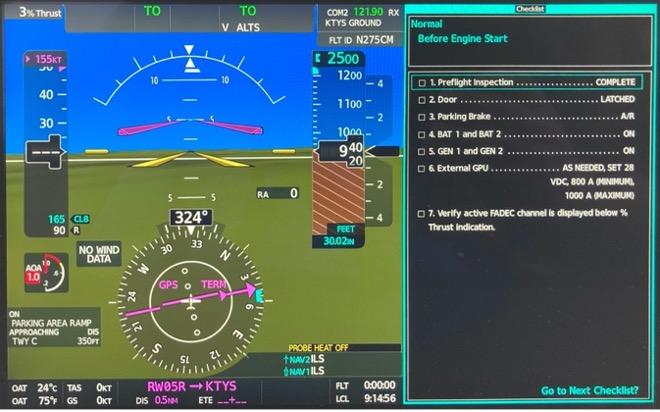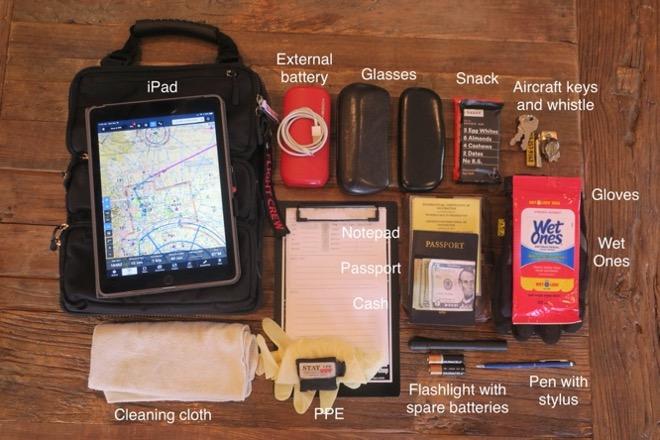
Most of the skills and techniques needed in a multi-pilot cockpit have their place when flying single pilot, but the requirements for proper planning and organization are even higher. The agenda of the 2021 NBAA Single-Pilot Safety Standdown, to be held in Room W206 at the Las Vegas Convention Center West Hall on Monday, Oct. 11, 2021, includes “Single-Pilot Aeronautical Decision Making,” “Customized Operating Procedures” and “Proactive Safety.”
Solo pilots, those without a copilot or another pilot in the cockpit, have long relied on acronyms and catchy phrases to remember what to do and when. These days there are many new tools that make these tasks easier, and modern computerized cockpits lower pilot workload and therefore increase safety. But it is still a challenge.
Pilots in multi-pilot crews need to pay attention too; in the future, multi-pilot cockpits will allow extended periods with just a single pilot. These techniques will become even more valuable for these “occasionally solo” pilots.
The first step is to know your aircraft, have the appropriate flight manuals and handbooks at the ready, and ensure checklists are designed optimally. A well-designed checklist will be short, will place the most important items up front, and will be easily accessible. Critical checklists intended for especially busy periods with high workload, such as the before-landing checklist, should be placarded on the instrument panel. Many new single-pilot aircraft can display checklists on primary flight displays, as shown in the photo of the Cirrus Vision Jet display. Even without the technology, all you need is a yoke-mounted clip to have the checklist right where you need it, as shown in the photo of a Piper Cherokee on base for landing.

Credit: James Albright/ShowNews
The second step is to remember that any flight is optional—you don’t have to go, and there are times you shouldn’t go. A single pilot doesn’t have a backup who is ready to step in. All pilots should remember “IMSAFE—AM I?” prior to every flight:
- Illness?
- Medication?
- Stress?
- Alcohol?
- Fatigue?
- Emotion?
- Am I tired, am I distracted, am I in a rush, am I legal (experience, recency, license, medical), and am I sure?
You should make it normal practice to become hyper-aware of the weather in the days leading up to the flight. Conditions may dictate your flight must be delayed or even canceled. Having alternate transportation already arranged will remove most of your “we have to go” pressures.
Make sure you get to the airport with more than enough time to ensure the aircraft is positioned, fueled and ready for flight. You may need extra time to load bags and brief passengers. Are all required aircraft inspections signed off? Is any extra equipment needed for the weather or other expected conditions? The day prior is also a good time to ensure all your portable electronics (iPad, phones, portable GPS, etc.) are fully charged and any apps you will be needing are up to date. Filing a flight plan a day early may help expedite your clearance to and from a busy airport.

Also remember to pack aircraft checklists, flight plans, charts, pencils and paper. You will find that having a good iPad or smartphone with aviation apps can be very helpful. A kneeboard and headset are good to have as well. An oximeter, portable GPS and a backup radio can be lifesavers. If you wear eyeglasses, a second set are required in most countries.
Once at the aircraft, remember “ARROW:”
- Airworthiness certificate.
- Radio station license.
- Registration certificate.
- Operating limitations.
- Weight and balance.
Give your passengers a “SAFETY” briefing:
- Seat belts and seats adjusted as required for takeoff and landing.
- Air vents (location, use).
- Fire extinguisher (location).
- Emergencies (exit door, evacuation plan, survival kit).
- Traffic (how to scan and notify the pilot and how to avoid distracting the pilot when busy).
- Your questions?
If you’ve never used an iPad for cockpit chores, you should explore the many excellent applications available for flight planning, charts, performance planning and other duties that normally require space-consuming books and clipboards filled with various papers. If you will be relying on electronics, be sure to have a backup. Many applications have smartphone equivalents, so you might already have a suitable backup device in your pocket.
Try to develop a cockpit organization plan that gives you access to everything you need within arm’s reach, but also stay put with turbulence or other unexpected aircraft movement. Once you have a system of organization down, try to stick to it so that you learn to reach for what you need quickly, without having to spend valuable seconds in “search mode.” Some pilots find having a backpack with lots of pockets works well and can make organization standard from aircraft to aircraft.
Once you are ready for engine start and the flight itself, try to keep the non-pilots in the loop with a brief description about what is happening and what is about to happen. This can be a great way of letting them know when your workload is high and that there will be time for idle conversation later in the flight. “We are about to descend into a busy airport, so I need to carefully listen to air traffic control while flying a very precise instrument approach.” This kind of play-by-play should continue until the aircraft is in the chocks and secured.
Single pilots can benefit from pilot/copilot “callout” procedures where key tasks are enunciated to ensure both pilots are in the loop. Using visual, aural and tactile senses ensures both pilots understand an instruction and a plan of action. If air traffic control clears the aircraft to a new altitude, for example, a two-pilot crew can ensure the clearance was heard correctly, remembered and executed. Let’s say the controller clears you to climb and maintain 8,000 ft. The copilot sets the altitude select knob and holds his or her hand there (tactile). The copilot announces, “eight thousand feet” (aural). The pilot points to the new altitude (visual), agrees to the clearance (aural), and either hand-flies or programs the automation for the climb (tactile). A single pilot should mimic this aural, tactile and visual method to avoid forgetting the clearance once acknowledged.
Another multi-pilot crew technique that can pay dividends in a single-pilot cockpit is known as “pointing and calling” key events. Let’s say you are approaching a taxiway intersection with a choice of turning left, going straight or turning right. Saying “I am about to turn left onto Taxiway Alpha” while pointing at the taxiway in the expected direction forces your eyes to look for taxiway signs and scan for conflicts. This technique may seem superfluous, but it can save you from making a mistake before it happens.
Finally, single pilots should take advantage of another opportunity usually reserved for multi-pilot crews: the post-flight critique. Take a few minutes after each flight and write a few notes about how things went and what could have been done better. Then prior to your next flight review the notes from previous flights. It is only through critique that we can most effectively improve, and single pilots can do that too.
If you are flying an aircraft certified to require more than one pilot, these techniques will also prove valuable when the other pilot is away for periods that the regulations call breaks for “physiological needs.” In the future, these breaks could be extended from just minutes to hours. Allowing one pilot to sleep during low workload periods can provide an increase in safety because that pilot will be more alert and rested for the high workload periods to come. Some manufacturers are already exploring options for pilot seats that recline fully into flat beds suitable for extended sleep periods during cruise flight. A pilot in a multi-pilot crew can very well become a single-pilot operator in these cockpits of the future.
The 2021 NBAA Single-Pilot Safety Standdown will be a good starting point for pilots of all sorts to meet with other pilots and learn more about these useful single-pilot techniques.





